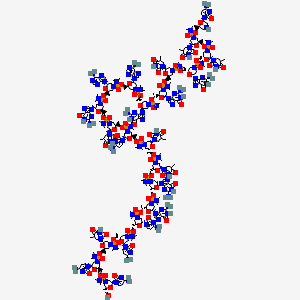

1. Viltolarsen
1. Viltolarsen
2. Ncnp-01
3. Gtpl11430
4. Ns-065
| Molecular Weight | 6925 g/mol |
|---|---|
| Molecular Formula | C244H381N113O88P20 |
| XLogP3 | -33.1 |
| Hydrogen Bond Donor Count | 29 |
| Hydrogen Bond Acceptor Count | 149 |
| Rotatable Bond Count | 122 |
| Exact Mass | 6923.3631358 g/mol |
| Monoisotopic Mass | 6921.3564261 g/mol |
| Topological Polar Surface Area | 2230 Ų |
| Heavy Atom Count | 465 |
| Formal Charge | 0 |
| Complexity | 21200 |
| Isotope Atom Count | 0 |
| Defined Atom Stereocenter Count | 42 |
| Undefined Atom Stereocenter Count | 20 |
| Defined Bond Stereocenter Count | 0 |
| Undefined Bond Stereocenter Count | 0 |
| Covalently Bonded Unit Count | 1 |
Viltolarsen is indicated for the treatment of Duchenne muscular dystrophy in patients confirmed to have a _DMD_ gene mutation amenable to exon 53 skipping. This indication represents an accelerated approval based on observed efficacy; continued approval for this indication may be contingent on the verification of safety and efficacy in a confirmatory trial.
Viltolarsen is an antisense phosphorodiamidate morpholino oligonucleotide designed to bind to and disrupt splicing of exon 53 in the human _DMD_ gene, which results in the expression of a partially functional dystrophin protein in patients who otherwise would not produce dystrophin. Despite a relatively short half-life, the physiological effect of producing relatively stable dystrophin protein allows for effective therapeutic benefit with weekly dosing. Viltolarsen may cause renal toxicity, and so kidney function should be monitored in patients. However, due to the alteration of serum creatinine in Duchenne muscular dystrophy patients, creatinine should not be used as a marker of renal function.
M - Musculo-skeletal system
M09 - Other drugs for disorders of the musculo-skeletal system
M09A - Other drugs for disorders of the musculo-skeletal system
M09AX - Other drugs for disorders of the musculo-skeletal system
M09AX12 - Viltolarsen
Absorption
Viltolarsen is administered by intravenous infusion and is assumed to have a bioavailability of 100%. In a phase 1 dose-escalation trial of 10 patients given either 1.25, 5, or 20 mg/kg weekly for 12 weeks, the mean Cmax was 6040 300 ng/mL in the low dose group and 70,200 44,900 ng/mL in the high dose group on initial dose, with the corresponding final dose values of 5640 2440 and 72,800 26,400 ng/mL, respectively. Similarly, the AUC0-t for the initial/final dose was 8410 1310/8410 3520 ng\*hr/mL for the low dose and 98,900 54,100/115,000 56,000 ng\*hr/mL for the high dose. The Tmax varied between 0.667 0.289 and 1.00 0.00 hours, and viltolarsen has a documented median Tmax of approximately one hour.
Route of Elimination
Viltolarsen is mainly excreted in the urine unchanged; in a phase 1/2 study of 16 Japanese DMD patients, 92.0-93.1% of a single 80 mg/kg dose of viltolarsen was recovered unchanged in the patient urine within 24 hours of administration.
Volume of Distribution
Viltolarsen has a steady-state volume of distribution of 300 mL/kg (14% CV) when given at 80 mg/kg. In patients given either 1.25, 5, or 20 mg/kg viltolarsen weekly for 12 weeks the volume of distribution was between 183 14 and 264 68 mL/kg.
Clearance
Viltolarsen has a reported plasma clearance of 217 mL/hr/kg (22% CV). Patients taking 1.25, 5, or 20 mg/kg viltolarsen weekly for 12 weeks had a total clearance of between 149 21 and 239 97 ml/hr/kg.
Viltolarsen metabolism was not detected in serum or liver-derived microsomes, and it appears not to be metabolized by either DNase I or phosphodiesterase type 1 _in vitro_. This lack of metabolism is consistent with what is known regarding the stability of phosphorodiamidate morpholino oligonucleotides to enzymatic cleavage.
Viltolarsen has a reported elimination half-life of 2.5 hours (8% CV). When administered at either 40 or 80 mg/kg for 24 weeks, viltolarsen elimination half-life was 2.38 and 2.82 hours, respectively.
Duchenne muscular dystrophy (DMD) is an X-linked recessive allelic disorder that results in the absence of functional dystrophin, a large protein comprising an N-terminal actin-binding domain, C-terminal -dystroglycan-binding domain, and 24 internal spectrin-like repeats. Dystrophin is vital for normal muscle function; the absence of dystrophin leads to muscle membrane damage, extracellular leakage of creatinine kinase, calcium influx, and gradual replacement of normal muscle tissue with fibrous and adipose tissue over time. The disease progresses from loss of ambulatory function to ventilatory insufficiency and cardiomyopathy, with death typically occurring in the second or third decade of life. The human _DMD_ gene contains 79 exons spread over approximately 2.4 million nucleotides on the X chromosome. DMD is associated with a variety of underlying mutations, including exon duplications or deletions, as well as point mutations leading to nonsense translation through direct production of an in-frame stop codon, frameshift production of an in-frame stop codon, or aberrant inclusion of an intronic pseudo-exon with the concomitant production of an in-frame stop codon. In all cases, no functional dystrophin protein is produced. Becker muscular dystrophy (BMD) is a related condition with in-frame mutations that result in the production of a truncated but partially functional dystrophin protein. BMD patients, therefore, have milder symptoms, delayed disease progression, and longer life expectancy compared to DMD patients. Viltolarsen is an antisense phosphorodiamidate morpholino oligonucleotide designed to bind to a specific region in exon 53 of the _DMD_ pre-mRNA and prevent its inclusion within the mature mRNA before translation. In patients with specific mutations, including those with deletions of exons 45-52, 47-52, 48-52, 49-52, 50-52, or solely of exon 52, this results in restoration of the expected reading frame and the production of a BMD-like dystrophin protein. Although fibrotic or fatty muscle tissue developed previously cannot be improved, this therapy aims to slow further disease progression through the production of partially functional dystrophin and alleviation of the pathogenic mechanism of muscle tissue necrosis.